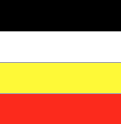Comprisation PART FIVE
Alchemy of Order
June, 2024

Previously on Comprisation...
In Part Four I provided a synopsis of Parts 1-3, so I won't recap them again here. We did a wrap-up with Johannes Kepler, and most importantly identified where his paradigm shift occurred. He abandoned mapping platonic solids after trying to fit a dodecahedron (based on pentagrams) between Earth and Mars. He then reverted to new observational data to get the orbit of Mars correct. The Ancients would have associated the Pentagram with Venus (not Mars) as its observed orbit creates a 5 sided figure every 8 years. It's the only celestial object that does that.
Hermetically Sealed is Air Tight
"Hermetic" is another term with a unexpected backstory. When reading "Hermetic Tradition" I always though it meant something completely sealed, so perhaps some highly insular way of doing things. Actually, ancient through current use comes from the Greek god Hermes, his association with Alchemy, and the alchemical technique of sealing a glass bottle so it was air tight. Hermes Trismegistus (Hermes the Thrice Great, 2nd to 3rd century BCE) is the attributed author of the "Emerald Tablet" that was purportedly discovered under a statue of Hermes in Hellanistic Egypt.
The Emerald Tablet
"Tis true without lying, certain and most true. That which is below is like that which is above and that which is above is like that which is below to do the miracle of one only thing. And as all things have been and arose from one by the mediation of one: so all things have their birth from this one thing by adaptation....Hence I am called Hermes Trismegist, having the three parts of the philosophy of the whole world."
— English translation of the Emerald Tablet by Isaac Newton, 1680
As mentioned previously, Newton had secret notebooks filled with over 1 million words on Alchemy. They were not published, nor intended for publication, so figuring out what parts of the content are original thoughts can be tricky. Clearly Newton also used the manuscripts to copy down information from other sources he deemed valuable. An archive of Newton's document images are here.
Translations of writing attributed to "Hermes Trismegistus" feature prominently and give clues into Newton's midset. This is from Manuscript 27:
" For I have discovered all that which hath been hidden in this science. I have declared a very great secret, & I have spoken all the science to them who can understand. "
And, of course, warnings about the dangerous nature are ever present:

Despite warnings, let's take a look at a diagram from "The Crowning of Nature" to which Newton added instructions for mapping to colours. (Newton is also famous for his book on Opticks and how a prism breaks white light into colors of the rainbow).
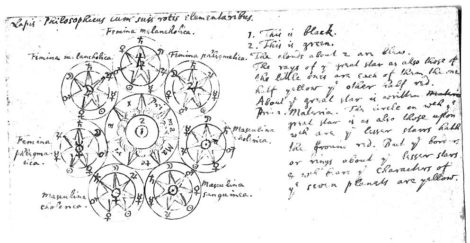
Here is a cleaned up version someone made without Newton's notes.
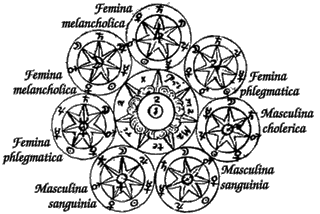
Things to notice here: There is a seven sided symmetry marked by the seven "wanderers" (corresponding to days of the week). Each circle is surrounded by another circle with another arrangement of the wandering "planets" (Sun & Moon were considered planets too). There is a central circle with perhaps more circle-within-circle arrangements.
The graphic below is from a different source of the same "Philosophers Stone" diagram, labeled "The Ancient Chaos" from the book "The Crowning of Nature." I currently believe the left-most image is a modern recreation by Adam McLean, and this very low res version is repeated across the internet. In the more legible, hand-made copies are also errors, either accidental or intentional, as the casual explorer will find. In the middle, the illustration is from the Cambridge Digital Library. I had hoped it was the same version Newton saw and hand copied, but you will notice a few important differences. Far right is perhaps an earlier version from the 1600s. It was being auctioned as the only copy in private hands:
"Modern students of The Crowning of Nature think that the work’s encoded message can be scientifically analyzed and even fully deciphered into specific chemical procedures and compounds" —PBA Gallery Auction Notes, 2018
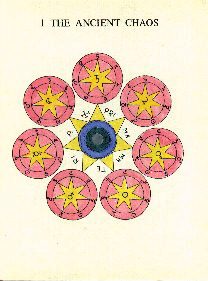
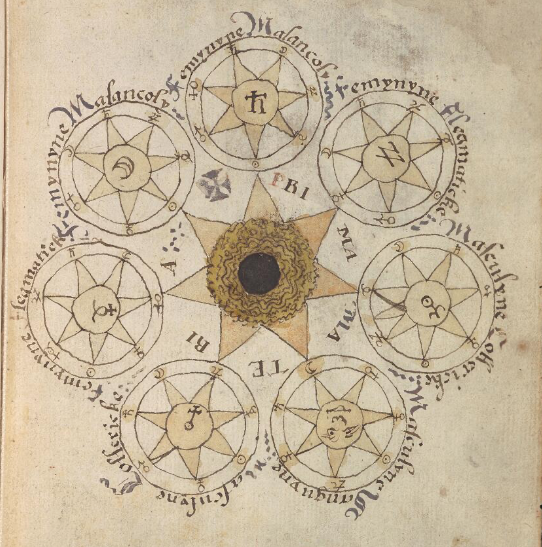
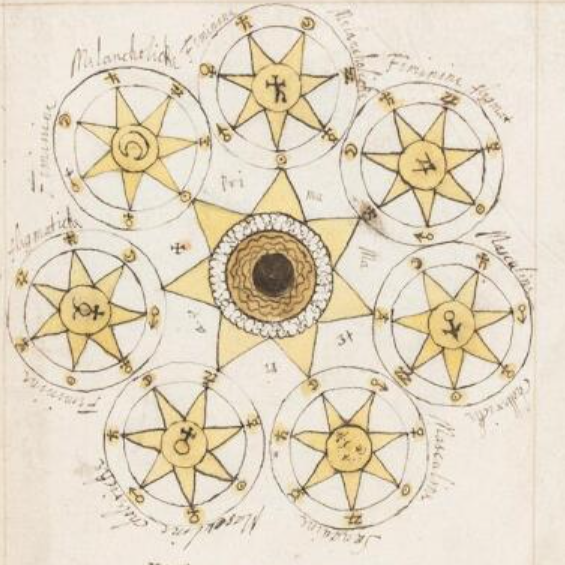
We already know where the study of Alchemy leads. But if this "Ancient Chaos" is the Renaissance equivalent to the Periodic Table of Elements, it's worth going over. Below is a complete re-creation I made after comparing several different versions, including the one in Newton's notebook.
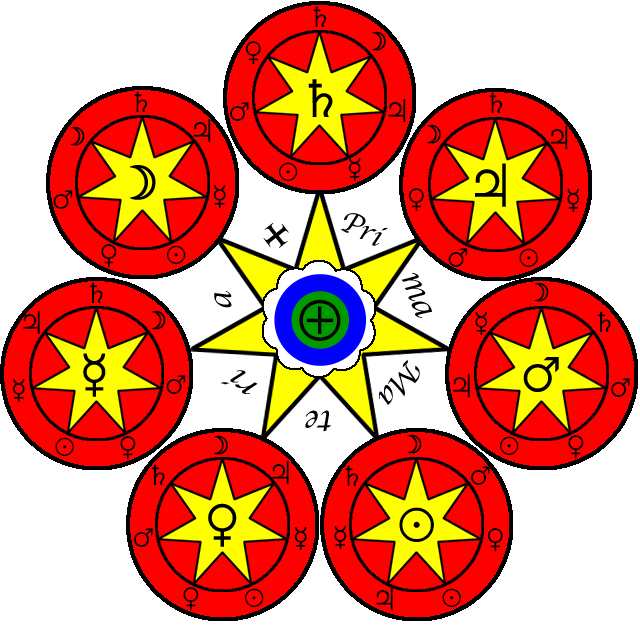
Here we see clearly each of the seven "planetary sigils" contained within wheels, surrounded by the same elements but with different rotations. Starting at the top and rotating clockwise we have:
- Saturn — ♄ - Lead
- Jupiter — ♃ - Tin
- Mars — ♂ - Iron
- Sun — ⊙ - Gold
- Venus — ♀ - Copper
- Mercury — ☿ - Quicksilver
- Moon — ☽ - Silver
Text around the central 7-pointed stars is a cute way of writing "Prima Materia" or First Matter. The middle circle in green represents the element Earth, and I used its planetary symbol. Next layer out is Water, then Air, and the star points represent Fire. These are the four Classic Elements and they are correctly arranged by increasing energy states. I explain this mapping further in "The Elements."
Since I had to hand map the position of every "sigil" around each circle, I attempted to discern the pattern. When the illustrations were low-res I assumed it would be the same pattern, of perhaps a simple rotation. Or even an exhaustive combination. But it's apparently none of those. If I take the position of each wheel furthest from the center, I can't really label it 12:00 because of the 7 divisions. But If I just label each of the 7 clockwise stopping points A-G it yields something to compare. You will notice this 12:00, or letter position "A" is always the same as the sigil in the circle's center star. That's consistant. Rows are all unique, but columns are not.
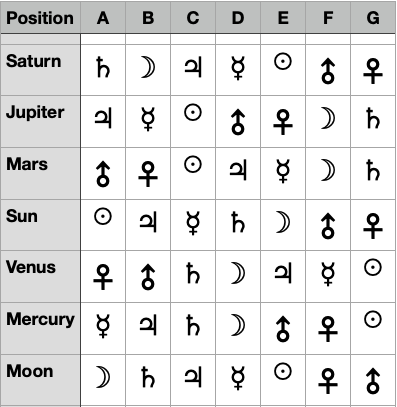
You might not notice at first glance, but there is another pattern — that of pairs. Three Pairs and the Sun stands alone for each circle. I color coded them below so you can see this easily. I thought this might be exhaustive permutations of the color pairs but Saturn assignments and Moon assignments match, even if you include the position of Sun. These two avoid completely duplication by swapping order within the pair color. Permutations are going on, but not exhaustively.
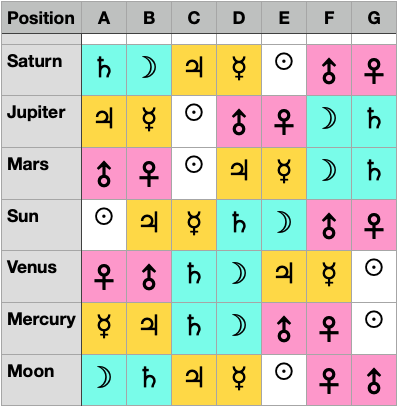
After I thought I was done trying to decipher "The Ancient Chaos" I noticed if I rotated the whole figure so the Sun ⊙ was at the top, the other pairs fell better into place. (I used the same color coding as the table.) You can also see the pairings ROTATE around the ring instead of any of them crossing the center. Since the Sun is the only planet not paired within the group, and the Sun symbol ⊙ is also to the symbol for elemental GOLD this seems like the obvious rotation. Why was the Sun not placed at the top to begin with? The symbol for Saturn also represents Lead, but the central star splits to Gold AND Quicksilver. Could this be more secret knowlege hidden through misdirection? Or could it mean elemental gold was not the desired result? Or something else?
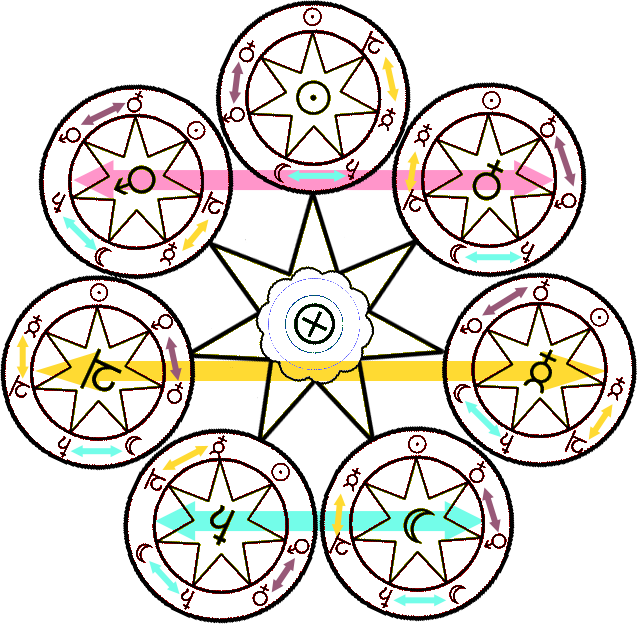
If you look at the 7-pointed star you can see a "Two things Merge into One" symmetry. This reflects the history where each Classic Element has two Qualities: [(Hot or Cold) AND (Wet or Dry)].
Re-examining the notes Newton made on his "Ancient Chaos" illustration, he maps each planet sigil to what is called the Theory of Humors. These are present on both authentic illustrations too. Aside from the Male/Female notation, the Aristotelean Qualities of [(Hot or Cold) AND (Wet or Dry)] come back into play with the Humors, following the same exact structure of Classic-Elements to Classic-Qualities mapping from the Leibniz diagram in "On the Art of Combinations."

This theory of bodily humors led to the practice of bleeding patients in an attempt to restore balance. But "humoral theory" was still considered an advancement in medicine as it focussed on a person's actual body, rather than displeasure of the gods, as a source of disease.

The Illustration below is from the Alchemical book Quinta Essentia (which translates to "The Fifth Element"), published 1574, 70 years before Newton was born. The Quinta diagram shows the 12 signs of the zodiac (not 7 planets) and the arrangement of maladies is not in the same order. But they are the same maladies based in bodily humors out of balance:
- Melancholic — Black bile imbalance. (Cold & Dry) - Autumn 🜃 Earth
- Phelgmatic — Phlem imbalance. (Cold & Wet) - Winter 🜄 Water
- Choleric — Yellow Bike imbalance. (Hot & Dry) - Summer 🜂 Fire
- Sanguine — Blood imbalance. (Hot & Wet) - Spring 🜁 Air
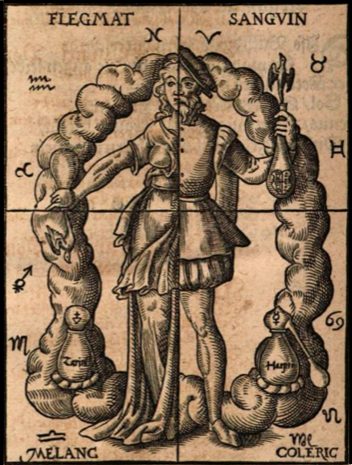
Quinta Essentia, Leonhard Thurneisser zum Thurm, 1574
The clockwise order presented by the Quinta illustration: Sanguin, Coleric, Melang, Flegmat; corresponds to what we expect for the Four Seasons: Spring, Summer, Autumn, Winter. I can justify reading it clockwise since the Zodiac signs are mapped that way too - Aries, Taurus, Gemini, Cancer ... and so on. So Quinta presents a rational ordering by Zodiac and Season, but doesn't match Newton's "Ancient Chaos" notation.
Another rational ordering would be the Four Classic Elements: Earth, Water, Air, Fire. These elements are arranged in that order in the Central Circle, and correspond to increasing energy states of matter (again, more on that in "The Elements.") This also does not match and cannot be rotated to match Newton's ordering of the Humoral Maladies. And why are they even there? Is this just sloppiness, or intentional secrecy? I'm pretty sure it's the latter.
Newton's notes on "mapping to colors" is a clue even without reading any of his text. The maladies all map to colors assigned to the elemental bodily fluids: Black (bile), White (phlem), Yellow (bile), Red (blood). And in that specific order. ("Phlem" as White might throw modern readers but it included the clear and white fluids, like saliva, mucus, pus and semen.) So in an Occult Manner, Newton annotated the "Ancient Chaos" with four colors in a particular order, in contrast to other apparent systems.
As far back as the first century, the oldest books on Alchemy describe the Magnum Opus or Great Work, as taking the "Prima Materia" through FOUR STAGES to create the philosopher's stone. These stages are:
- nigredo — The Blackening
- albedo — The Whitening
- citrinitas — The Yellowing
- rubedo — The Reddening
We will continue with the fours (color) stages in the last section MAGNUM OPUS, but there is one last detail with the "Ancient Chaos" diagram and the slightly obscured "Pri" "ma" "ma" "te" "ri" "a" "🜊". So Prima Materi 🜊. What is the last strange character? It turns out to directly represent "Vinegar", or "Acid" and is usually combined with other symbols. But in this context 🜊 is one of MANY names of the "Prima Materia" according to a list of about 50 from Martin Ruland's 1612 alchemical dictionary, Lexicon alchemiae sive dictionarium alchemistarum.
I am going to "Cherry pick" a few known synonyms for Prima Materia to make a point in the final section:
- Microcosmos
- Water of Life
- Urine
- Syrup
- White Smoke
- Fiery and Burning Water
- Stella Signata and Lucifer
Shifting from Planetary sigils to Color Stages, and coupled with synonyms for Prima Materia reveals a rational interpretation of the "Ancient Chaos" in this final section — Magnum Opus
